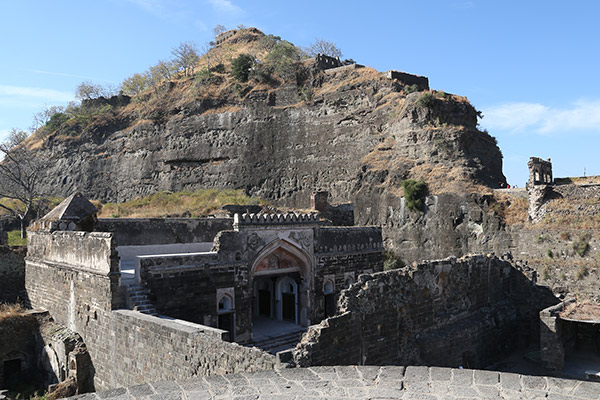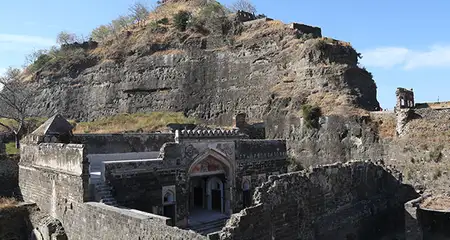Daulatabad Fort is a fortified citadel located atop a conical hill in Aurangabad, about 200 meters above the sea level. Its strategic location, incredible architecture, and three-layer defense system made it one of the most powerful hill fortresses of the medieval period. It served as the capital of the Yadava Dynasty and the Delhi Sultanate (for a brief period) as well as the secondary capital of the Ahmadnagar Sultanate at different points in history. The fort, which now is a key tourist attraction in Aurangabad, offers spectacular views of the surrounding areas.
Want to know more about this fascinating fortress with over 800 years of legacy? This blog has all the interesting details about Daulatabad Fort such as its architecture, defense features, history, entry fee, timings, nearby attractions, and lesser-known facts.
Daulatabad Fort, Aurangabad Information
| Location | Maharashtra State Highway 22, Daulatabad |
| Also Known as | Devagiri Fort or Deogiri |
| Type | Hill fortress |
| Timings | 9:00 am to 6:00 pm; every day |
| Entry Fee | ₹ 10 for Indians; ₹ 100 for foreign tourists |
| Photography and Videography | Allowed; ₹ 25 charged for video cameras |
| Distance from Aurangabad City | 17 km |
| Distance from Major Transportation Hubs | Aurangabad Airport (27 km); Aurangabad Railway Station (19 km) |
| Commissioned by | Raja Bhillama V of the Yadava Dynasty |
| Construction Started in | 1187 (fortification work was continued by various dynasties till the 17th century) |
| Area | 94 hectares (approx.) |
| Transportation Options | Ellora-bound MSRTC buses, auto-rickshaws, and cabs |
| Prominent Features | Formidable defense aspects and secret escape routes |
Daulatabad Fort, Aurangabad: History
The construction of Daulatabad Fort is credited to Bhillama V, the first Yadava king, who commissioned it around 1187 AD. He also established a township around the site and made it his capital. At that time, it was known as Deogiri, which means the Hill of the Gods. It continued to be the capital of the Yadavas till 1296 AD. Later, the fort came under the possession of several dynasties ruling the Deccan.
Sultan Alauddin Khalji of the Khilji Dynasty annexed the fort in 1308 during his reign over the Delhi Sultanate. When it came under the control of Sultan Muhammad Bin Tughluq in 1327, he renamed it Daulatabad. He further shifted his capital from Delhi to Daulatabad and ordered a mass migration of his subjects from Delhi to the fort city. But in 1334, he shifted his capital back to Delhi.
Shortly after this, the fort came under the Bahmanis who added many structures to it including the Chand Minar, one of the famous minarets in the country. Later in 1499, it was passed on to the hands of the Nizam Shahis of Ahmednagar who also fortified the structure. The Mughals captured the fort in the 17th century and in the next couple of centuries, it passed several hands including the Marathas, Peshwas, and finally, the Nizams of Hyderabad who had it under their control till India gained independence.
Daulatabad Fort, Aurangabad: Architecture and Defense System
Spread across an area of over 94 hectares, the Daulatabad Fort Complex is a fine example of architectural genius. It used to house small fortified sectors that served specific purposes. These included Ambarkot (area for common people), Mahakot (residential area for people belonging to higher social strata), Kalakot (royal residential area), and Balakot (the pinnacle of the fort where the flag fluttered).
The fort complex also housed several structures including palaces, public audience halls, reservoirs, step wells, temples, mosques, court buildings, gigantic tanks, royal baths, and a victory tower, among others. Many of these structures were added to the fort as it passed from one dynasty to another. The citadel also had a unique water management system, several cannons, and ten incomplete rock-cut caves.
Back in the golden days, the fort boasted of a robust defense system comprising of a wet moat, a dry moat, a glacis, and three fortification walls with bastions and gates at regular intervals. A narrow bridge, where only two individuals can walk at a time, was the only means of access to the fort. A rock-cut tunnel, lofty gates equipped with iron spikes, gun-turrets positioned at strategic locations, false doors, stone wall mazes, complex entryways, and curved walls were its other prominent defense features. Unlike other forts, a single doorway acted as the entry and exit point of the fort.
Daulatabad Fort, Aurangabad: Today
Today, Daulatabad Fort is one of the top tourist places to visit in Aurangabad and a major historical attraction in the region. Maharashtra Tourism Development Corporation (MTDC) has declared it as one of the seven wonders in the state. While the fort has suffered some damage due to the lack of proper management, it is still in good shape. Many of the structures inside the fort complex are also in a well-preserved condition.
Things to See in the Daulatabad Fort Complex, Aurangabad
With several interesting structures and defense features, Daulatabad Fort makes for an interesting visit. Some of the main attractions at the fort include:
- Bharat Mata Temple, a temple housed within the complex. It is believed to be one of the oldest structures at the fort and features the layout of a mosque. A statue of Bharat Mata was installed within it after independence and hence the name
- Chand Minar or the Moon Tower, the victory tower built by Sultan Ala-ud-Din Bahman Sha of the Bahmani Sultanate. The minaret, which is modeled on the famous Qutub Minar, has a height of about 64 meters and features circular balconies, several chambers, and a small mosque at the base
- Baradari, a lavish structure with 13 halls. This octagonal building used to be a royal palace which is believed to have been built in the 17th century during Shah Jahan’s visit
- Chini Mahal, a double-storied building where Aurangzeb kept the king of Golconda, Abul Hasan Tana Shah, imprisoned for 12 years
- Andheri, a dark passage with twists and turns built into it to confuse and trap intruders
- Aam Khas building, a huge hall meant for the public audience
- Rock-cut Caves that belong to the Yadava period
- Cannons including Durga Tope, Mendha Tope (the largest one in the fort), Kala Pahad, and many others
- Saraswati Bawdi, a stepwell near the main entrance
- Hathi Haud or Elephant Tank, a colossal water tank that has a capacity of about 10,000 cubic meters
- Kacheri, a building featuring two stories and a courtyard
- Rang Mahal, a rectangular building with carved woodwork
Read also – Things to do in Aurangabad
Lesser-known Facts about Daulatabad Fort, Aurangabad
- The fort had well-designed false gates on the left with a flag mast but the real gates were on the right side. This was done to confuse attacking armies
- Since the hill was shaped as the smooth back of a tortoise, enemy armies could not utilize mountain lizards as climbers to access the fort
- The Chand Minar at the fort is among the top three tallest minarets in India
- The fort had spiked gates to prevent attack by elephants
- Moving his capital from Delhi to Daulatabad Fort was one of the failed experiments of Muhammad Bin Tughluq that earned him monikers like the ‘Wise Fool’ and ‘Mad King’.
Attractions near Daulatabad Fort, Aurangabad
- H2O Water Park (3 km)
- Tomb of Aurangzeb (9 km)
- Shri Bhadra Maruti Temple (11 km)
- Ellora Caves (13 km)
- Jyotirlinga Grishneshwar Temple (14 km)
- Goga Baba Hill (15 km)
The historical Daulatabad Fort is a testimony to the ancient engineering practices of our country. Make sure to carry a bottle of water and wear comfortable shoes when you visit this hill-fortress. And while in Aurangabad, don’t forget to visit other natural and manmade wonders such as Soneri Mahal, Panchakki, Aurangabad Caves, and Bibi Ka Maqbara, among others.

























